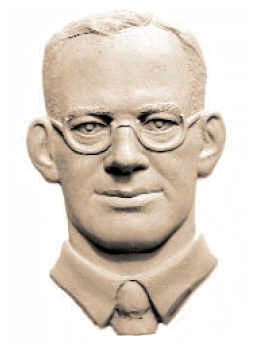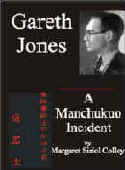Gareth Jones
[bas relief by Oleh Lesiuk]
HOME |
Stop Press |
Complete Soviet Articles & Background Information |
Précis of Gareth's
|
All Published Articles |
BOOKS
|
|
|
|
More Than Grain of Truth(2005) |
|
|
TOPICAL
'Are you Listening NYT?' U.N. Speech - Nov 2009 |
Gareth Recognised at Cambridge - Nov 2009 |
Reporter and the Genocide - Rome, March 2009 |
Order of Freedom Award -Nov 2008 |
Premiere of 'The Living' Documentary Kyiv - Nov 2008 |
Gareth Jones 'Famine' Diaries - Chicago 2008 |
Aberystwyth Memorial Plaque 2006 |
GENERAL
Scholarship Fund |
Site Map |
Links |
Legal Notices |
Sponsored Links |
Contact |
Boston Sunday Advertiser. Published date: [approx] 11 June 1933
Article No.2 of 2 - Syndicated by the New York American Inc..
Soviet
Collective Farm Move Caused Famine in Russia, Says Gareth Jones
Human Factor Ignored in Five-Year Plan, He Declares
By GARETH JONES
Former
Foreign Affairs secretary to David Lloyd George, Who recently completed a visit
to Soviet Russia, with which he is familiar, speaking Russian fluently.
London, May 1933. [Approximately May
14th 1933]
The
famine now killing hundreds [sic] in the Soviet Union cannot be attributed to the
weather, for in the last few years climatic conditions have - with the exception
of drought in some areas in 1931 - blessed the Soviet government. Then why
the catastrophe?
The famine man made.
It
is the result of the Soviet policy of abolishing the private farm and. replacing
it by large collective farms, where the land and cattle were owned in common.
This policy of collectivisation, rushed with madcap speed during the Five Year
Plan, aimed at Americanising the grain fields of Russia.
The
wheat fields of the United States formed, an example the Bolsheviks sought to
imitate. The tiny patches of the small peasants were to disappear and
thousands of tractors were to sweep across vast areas. Science was to
increase production with fertilizers.
By
1933 this great revolution was to make Russia again the granary of the world.
Large scale farming under Communist direction and without private ownership of
land was to be the salvation of the Bolsheviks.
The Soviet leaders took everything into account except one thing - the human factor. They studied the soil, the tractor, science, fertilizers, - but omitted MAN. As a result Paul Schaeffer's prophecy list collectivisation would be the doom of Communism, is likely to become reality. .
Land
Hunger.
That’s
What Made the 1917 Revolution
The
Russian peasant has been too powerful for the Soviet Government. In a
series of visits to Russia I have had hundreds of conversations with Russian
peasants and analyzed them. There are four dominant ideas running through
almost all these conversations. They are:
1.
LAND. 2. BREAD. 3. COW. 4. LIBERTY
These
four words sum up the mentality of the Russian peasant. How many times
have I heard them say: “I want my own land. How can I be happy unless I
have my own land? Why should I work if I have not got my own land?”
The
land hunger of the Russian peasant made the 1917 revolution. Throughout
the centuries his cry has been: “Land, more land!” Through the
revolution he increased his supply of land and became more capitalistic than
ever.
When
the Five Year Plan was organized by the Soviet Government the land was taken
away from him. No wonder he sulked and would not attend to the soil.
What
would an American farmer do if the police took away his soil? His reaction
would be far more violent than mere sulking. Only in isolated cases did
the Russian peasant murder the Communists from the towns, although many villages
revolted. His usual revenge was to take to the stove and neglect the
fields.
Two-thirds
of the peasants have been collectivized and no longer own their land. They
have resorted to passive resistance hence bad crops, epidemics of hundreds which
now curse the Russian countryside.
Confiscation
Government
More Grain Than Tax Seizes
“Bread’
is the Second dominant note in the peasant’s mind. A month ago a
Ukrainian expressed this admirably to me when he said: “I don’t care whether
I work for a landowner or a Communist or a Polak, as long as he gives me enough
bread.”
The
grain raised by the peasants was violently seized in the grain collections.
Women peasants would lament to me: “They took all our grain away, there is no
bread. How can we live?”
The
collective farms are associated in the peasant’s mind with the seizing of
grain and the absence of bread.
“Why
should we work when everything we produce is taken away from us?” ask the
peasant.
Often
the Government did not pay the peasant for the grain it seized, and when it did
pay, the sum (from 90 kopecks to 1 ruble 50 kopeks per pood - 36 lbs. of wheat)
meant sheer confiscation. Moreover, the peasant cannot work without bread.
Physical weakness, as well as passive resistance, keeps him to his stove.
The
“cow” plays an important part in the peasant’s mental make-up. To
him it is wealth and happiness. Joining the collective farm meant in most cases
giving up the cow to the common good. Peasants would say: “Why should I
give up my cow to, the others? Why should drunkards and good-for-nothings
have the benefit of my cow?”
When
the government attempted force to make them yield their cows they retaliated by
massacring their cattle and eating them.
The
massacre of the cattle was especially widespread. In January and February,
1930, before Stalin issued his cry of “Halt!” The Soviet Government
then repented of its policy of depriving the peasant of his cow. In some
collective farms the peasant is allowed to keep one cow, but it is too late,
however, for there is a grave lack of fodder.
Millions
of cattle were confiscated from peasants and sent to newly formed cattle
factories, where they died of exposure and epidemics.
Kulaks
Hardest
Working of All Peasants
So
great has been the inroad upon the livestock of Russia since the Five-Year Plan
became effective that not until 1945 could livestock reach the level of 1928.
The date, given to roe by one of the most reliable foreign experts in Moscow,
will only see the 1928 level reached provided there is fodder, no disease and
plans for importing cattle are successful.
“Liberty”
has been another guiding force with the Russian peasant. He objects to
being driven about in the collective farms by young Communists from the towns.
While force may lead to achievements of abort duration, it cannot make one
hundred and twenty million peasants increase their production.
Moreover,
force has led to the uprooting of six or seven million “kulaks” - the former
wealthy peasants. These have been sent to exile with a barbarity not
realized by the outside world.
Policy
Soviet
Plans to Crush Opposition
Near Moscow I saw a group of hungry, miserable peasants being driven along by a Red Army soldier with his bayonet fixed. This sight recalled one conversation I had with a woman peasant who said: “Look at what they call the Kulaks. They are just ordinary peasants who have a cow or two. They are murdering the peasants, sending them away anywhere. It is oppression, oppression, oppression!”
[See
Gareth's actual diary notes which quote this account of his travels by clicking
here.]
The
“kulaks” were the richest, hardest working peasants and their destruction
means a great loss to Russia’s national wealth.
The
Soviet policy of collectivization has collided with the mentality of the Russian
peasant and his passive resistance has won. Add the disastrous fall in
world prices, which forced the Soviet government to export more and more grain,
butter and other foodstuffs to meet its obligations abroad, and one has a
general view of why famine now exists in Russia.
What
of the future? One of the most decisive Spring sowing campaigns in Russia’s
history is in progress. To try and gauge the result of this campaign, I
asked these questions in March in each village I visited:
1—What
were the Winter sowing and ploughing like?
2—Have
you seed?
3—What
will the Spring sowing be like?
The
Winter sowing and ploughing had in all regions been bad. In some parts
there had been hardly any Winter sowing. Winter sowing accounts for about
one-third of the total harvest. Much of the seed was eaten last Fall.
In
many villages seed was lacking. Experts assert, however, that the
government has far greater reserves of seed than in 1921, and that it has well
supplied the Ukraine with seed. But there is a definite lack of seed in
many districts. Danger exists that if there is not the right quantity of
seed, weeds will win and throttle the grain.
When
asked about the prospects of Spring sowing, the peasants would reply: “How can
we sow when we are all weak and swollen? How can we sow when in a month we
may have no more cattle fodder to eat when our horses have died and we cannot
plough?”
Bleak
Future
folds Little Hope for Masses
The
most important factor in the spring sowing is the absence of horses and
tractors. In many villages about four-fifths of the horses had perished
and those that remained were weak and diseased. There were not sufficient
tractors to compensate for the death of the horses.
One
wise peasant put the problem concisely: “A horse is better than a tractor.
A tractor goes and stops, but a horse goes all the time. A tractor you can
only use in certain seasons, but a horse you can use all the year round. A
tractor cannot give manure, but a horse can.”
The
outlook for the next harvest seems, therefore, very black, although perfect
climatic conditions may offset part of the unfavorable factors.
Perhaps
the new agricultural policy of the Soviet Government will help. It is,
first, to send many thousands of town workers, called the Political Department,
into the villages. Their task will be to crush all opposition and organize
work in the collective farms. They are ruthless men who may be relied upon
to do their task with violence. While they may succeed in terrorizing the
peasants, it is difficult to see how they can succeed in increasing the harvest.
Disaster
Attempt
to Uproot Peasantry Fails
The second point of the governments new policy is the new agricultural tax, by which the collective farms will pay in tax so much gain (usually about 2 ½ centners) per hectare of the sowing area PLANNED, and be free to sell the rest in open.
I
asked some peasants about that. One said:
“Yes, they said it would be alright last year to sell the surplus on the private market, yet they took everything away. We do not believe them any longer. They say they will only take 15 poods per hectare, but they will take everything.”
In
most districts the yield will be so small that it may be less than the tax.
The peasants have so lost faith in the government that the new policy will not
encourage the peasants to work. The outlook for the harvest therefore,
remains black in spite of the new policy.
From
1917 to 1921 the Bolshevists uprooted the nobility and the bourgeoisie and
Russia survived. From 1928 to 1933 they have tried to uproot the
peasantry, and the result has been disaster.
Copyright,
1933 by N. Y. American, Inc.
This is the second article by Gareth Jones on famine conditions in Russia
|
|
|
|



